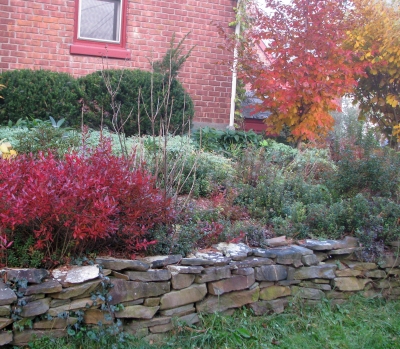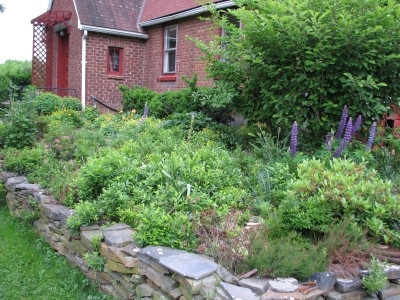HEATHERS & BARBERRIES & TICKS, OH NO!
An Evil Beauty
Uh oh! I was pulling an odd weed here and there in my heath bed and came upon a seedling of Japanese barberry (Berberis thunburgii). Should I start checking myself for deer ticks? Are all the plants in the bed soon to expire?
Japanese barberry is a commonly planted ornamental that was introduced into this country almost 150 years ago. For decades upon decades, it sedately graced landscapes with its boxwood-like leaves (but not evergreen), yellow flowers, and bright red berries, all set off against a backdrop of dark brown, thorny stems.
For some reason, the plant began to spread about 35 years ago. Perhaps it was the increased planting of barberries around homes, along highways, and outside shopping malls. Those plants spawned yet more plants as birds ate the berries and spread the seeds. Perhaps it was the surge in deer populations, a response to the creep of suburbia as well as to the decreased number of humans willing to take to the woods, rifle in hand, to fell a deer. All the while that deer were munching away on our roses, rhododendrons, yews, and other landscape plants, they rarely browsed barberry.
Okay, so more deer means more Lyme disease. Deer blood is what nourishes adult ticks and, as they feed, they reproduce and hitchhike across the landscape on their deer hosts.
But the Lyme bacteria actually get into the ticks only after feeding on the blood of small rodents, such as white-footed mice, that are harboring the bacteria. Recent research in Connecticut has shown that barberry also creates a very nice, sheltered habitat for mice.
To make matters worse, barberry also makes things homey for the deer ticks themselves, mostly by providing humidity. A forest with barberry growing in it hosted 120 Lyme-carrying ticks per acre; without barberry, a mere 10 per acre.
Earthworms, Friends No More?
So much for the threat of Lyme disease in my heath bed. What about the demise of the plants there?
Turns out that barberry is also prime habitat for earthworms, which, at first blush, would seem like a good thing. After all, earthworms are a gardener’s friend, right? Maybe. North of where the last glacier descended, the southern extent of which cut into much of northern U.S., all native earthworms were wiped out. The natives have been very slow to re-colonize but earthworms from Europe and Asia that arrived here in ship hulls and soil, and as fishing bait, have not been shy. They’ve spread rapidly.
Non-native earthworms thrive especially well in the soil beneath barberry bushes. It could be that barberry leaves are more digestible to them; it could be that barberry alters the soil chemistry to their liking.
These exotic earthworms are good at gobbling up raw organic matter, as in the leaf litter that blankets our forests — and my heath bed, to which I import leaves. The newcomers can actually gobble up forest litter faster than it is replenished, changing the soil habitat and exposing the soil to erosion. Plants in the heath bed, i.e. plants in the heath family, like that leaf litter; it keeps the soil cool and moist and, as it slowly decomposes, enriches the soil beneath with decomposed organic matter, or humus. There is some evidence that the makeup of our native forests, which includes rhododendrons, also in the heath family, is changing due to the work of exotic earthworms.
And all this from barberry!
Some Redemption
I’m not all that worried about ticks or the demise of my heath bed. The bed is small enough and watched closely enough so that all barberries can be ripped out — just like the one I saw yesterday. My cat keeps mice at bay, and my dogs do likewise for deer. And I import more leaves each year than earthworms, even exotic ones could gobble up.
The extensiveness of wild settings makes barberry control there difficult. Options there are cutting, pulling, fire, and/or herbicides.
No need for such drama In a home landscape. Here, barberry is easily controlled, if desired, by nothing more than being pulled out or repeatedly cut to the ground. One or a few bushes are not going to significantly impact mouse populations or Lyme hazard. Their greatest impact would be to make berries that, with the help of birds, would further the spread of this bush. Newer, sterile varieties offer ornamental mounds of greenery that don’t contribute to the plant’s spread.
Heather, and Friends
My heath bed, incidentally, has no heath plants. Heaths (Erica spp.) would die from in our cold winters. I call my bed a “heath bed” because in it I grow Heath Family (Ericaceae) plants in it: rhododendrons, mountain laurels, lingonberries, huckleberries, swamp azalea, and some heather (Calluna spp.). I group these plants together because all demand special soil conditions, conditions quite different from that of most cultivated plants.
Most heath plants need a soil that is very, very acidic, relatively infertile, well-aerated, consistently moist, and rich in organic matter. As mentioned above, these plants thrive where the ground also has a mulch of leaf litter, wood chips, or other organic matter, a mulch that disappears too quickly where soils harbor large populations of the non-native earthworms that thrive beneath barberry bushes.





Lee, is there any way I can find out whether or not my barberry is sterile?
If you know the variety, you can look it up. I’m not sure, but you could possibly look at the flowers to see if they are — hopefully — missing their female parts.
Can soil be both “relatively infertile” and “rich in organic matter”?
Yes, that is an odd combination. Such soils are the native habitat of blueberries. That’s why abundant use of compost or manures are not recommended for blueberries. Peat soils are typically infertile but rich in organic matter.
About five years ago we started our “weedless garden”. All went well until about three years ago we noticed the invasive “jumping worm” in the garden. The one inch of compost we apply is turned to worm castings within a month or so after we put it on. We end up with several inches of worm castings. No soil. The real difficulty is keeping it wet. We use drip, but on a very hot day the castings will be bone dry between drip sessions making it hard to direct sow. Once plants are up we use grass clippings as a sun block. The worms don’t seem to eat the grass and the drip can keep up.
Just passing this along. – Gary
I didn’t realize there are still Native earthworms to the region now called the united states of America. What are they? where can we find them to help them flourish?
Great info about the glaciers killing our native worms… I didn’t know that.
Native earthworms were never wiped out south of where the last glacial descended. Help them flourish by avoiding pesticides and soil compaction, and feeding them and the soil with organic materials.